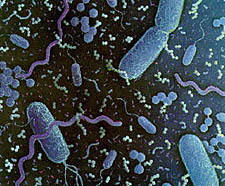Basic Information and Taxonomy
Streptomyces griseus itself
without context would not meant a whole lot to most people. So
first of all, in English "streptomyces" means aeorbic bacteria
and "griseus" means the color grey. Putting these together
gives us a simple image of what the species of bacteria now
looks like.
We can now work our way up through the taxonomy
itself to allow the complete understanding of where this bacteria exists
according to everything else. For starters, the genus is already in
the name itself, Streptomyces. Under this category it can be inferred
that these bacteria are aeorbic; as stated above.
From this we move up into the family level,
which in the case of this particular species, is Streptomycetaceae. This
broadens the spectrum of bacteria further by including all bacteria who form
structures similar to the unrelated vegetative mycelia found in fungi.
Finally, most bacteria under this family are found in soil.
Actinomycetales is the order from which
these families then stem from. Bacteria under this order are gram positive
and are often differentiated by the mass creation of natural metabolic
products to further their ends; streptomycin for instance.
The phylum that Streptomyces griseus belongs
to is the Actinobacteria. This vast grouping of bacteria contains all gram
positive bacteria and contains a "large amount of guanine-cytosine linkages
in their genetic material," (Johnston, 2003). Another example of this would be Salinispora
tropica.
Outside of this there is the kingdom of
Bacteria. This includes both gram positive and negative bacteria along with
all the different kinds of bacteria from cyanobacteria to parasitc
organisms.
Last but by no means least is the vast
overarching domain of Prokaryotes. This includes all organisms that
do not have a true nucleus and lack membrane bound organelles among other
things.
This picture shows a very small amount of the variation that is possible just among bacteria!
(Provided by NASA)
Next we'll go through some more
visual examples of the taxonomy we witnessed here to put an image to the
information you just obtained:
